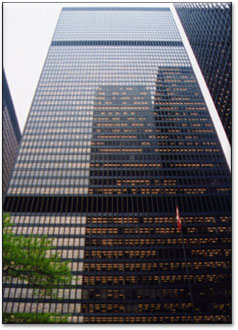Proposition
3: The perspectival images of parallel lines that are
neither parallel nor perpendicular to the picture plane converge onto a vanishing
point at some location away from the principal vanishing point (and which
is not necessarily within the confines the picture). The location of the vanishing
point is determined by the angle of its parallels to the eye.
| |
|
 |
|
|
 |
|
|
Fig. 2.10 A Toronto skyscraper |
Proposition 3 may be exemplified by a slanted
picture plane. If the picture plane is not vertical, the images of all vertical
lines converge onto the one and only vertical vanishing point (Figure
2.10). Figure 2.11 illustrates this property as it occurs in a picture of
a box projected onto a picture plane tilted sharply downward. Next, consider
a set of horizontal lines. They too converge onto a vanishing point. To specify
the location of this vanishing point, we must first define the horizon
line of the picture (see Figure 2.12), which is the line defined by the
intersection the picture plane (which need not be vertical) and a horizontal
plane that contains the center of projection. Any two horizontal lines that
are parallel to each other intersect the horizon line at the same point, which
is their horizontal vanishing point.
It can be confusing at first to realize that when one looks at a picture like
Figure 2.11, one cannot tell whether the box was slanted and the picture plane
was vertical, or the box was upright and the picture plane slanted (as we
described it to be).11 Had we described it as the picture of a
slanted box projected onto a vertical picture plane, we would have had to
relabel the vanishing points, for the box would have neither horizontal nor
vertical surfaces and the vanishing points of the cube would therefore not
lie on the horizon line.
This point can be further clarified by noting that in
Figure 2.2 one projecting ray is singled out and given a name its own: It
is the principal ray, that is perpendicular to the picture plane.
It is along this line that one measures the distance between the center of
projection and the picture plane. The principal ray is the projecting ray
that runs perpendicularly from the center of projection into the picture,
whatever the slant of the picture plane. If the canvas (or film plane) is
rotated upward to encompass a tall tower, the principal ray is correspondingly
rotated upward.12 In Figure 2.4, the principal ray intersects the
picture plane at the horizon. This is true only in the special case when the
picture plane is vertical.13
Having described various approaches to perspective construction, we are now
ready to consider the reconstruction of a scene from its perspective representation.
This scene inference problem is known as the inverse projection problem.
In common with many inverse problems, it cannot be solved without some assumptions.
To solve the inverse projection problem, we need only one assumption: that
we know the shape of one object in the scene. Thus, if we know that a particular
floor-tile is square, that tells us that it has both right angles and a length/width
ratio of one, defining the projective shape of the entire floor grid. These
considerations lead to the final proposition:
